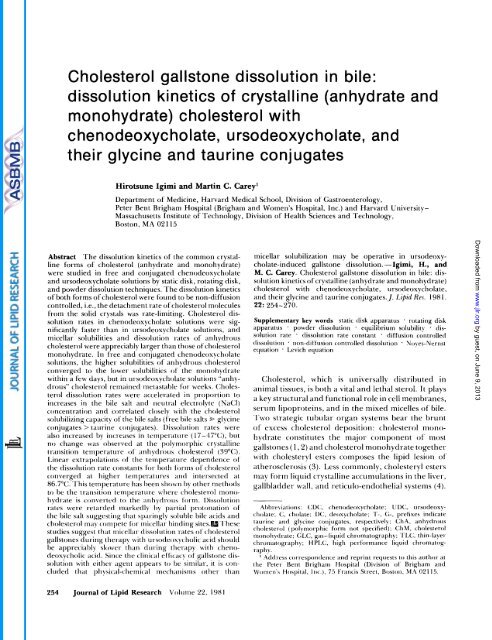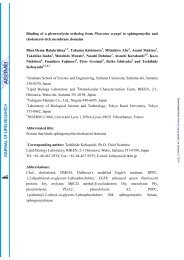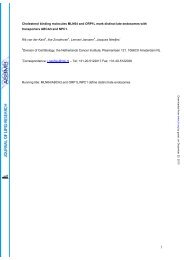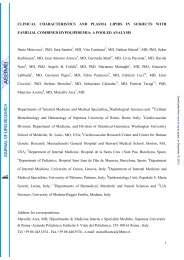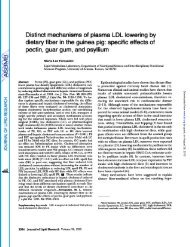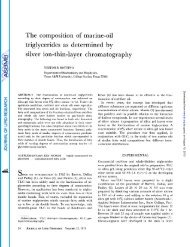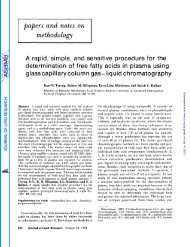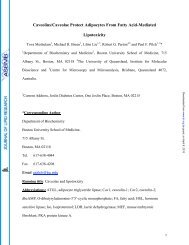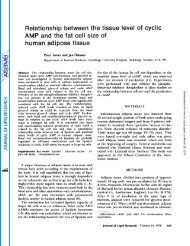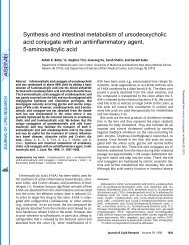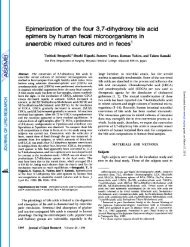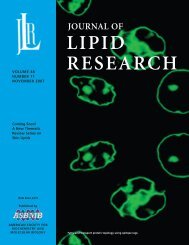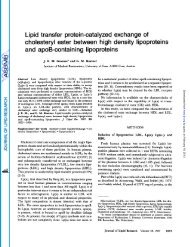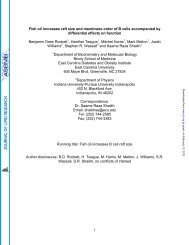Cholesterol gallstone dissolution in bile - The Journal of Lipid ...
Cholesterol gallstone dissolution in bile - The Journal of Lipid ...
Cholesterol gallstone dissolution in bile - The Journal of Lipid ...
Create successful ePaper yourself
Turn your PDF publications into a flip-book with our unique Google optimized e-Paper software.
<strong>Cholesterol</strong> <strong>gallstone</strong> <strong>dissolution</strong> <strong>in</strong> <strong>bile</strong>:<br />
<strong>dissolution</strong> k<strong>in</strong>etics <strong>of</strong> crystall<strong>in</strong>e (anhydrate and<br />
monohydrate) cholesterol with<br />
chenodeoxycholate, ursodeoxycholate, and<br />
their glyc<strong>in</strong>e and taur<strong>in</strong>e conjugates<br />
Hirotsune Igimi and Mart<strong>in</strong> C. Carey'<br />
Department <strong>of</strong> Medic<strong>in</strong>e, Harvard Medical School, Division <strong>of</strong> Gastroenterology,<br />
Peter Bent Brigham Hospital (Brigham and Women's Hospital, Inc.) and Harvard University-<br />
Massachusetts Institute <strong>of</strong> Technology, Division <strong>of</strong> Health Sciences and Technology,<br />
Boston, MA 021 15<br />
Abstract <strong>The</strong> <strong>dissolution</strong> k<strong>in</strong>etics <strong>of</strong> the cotnn~on crystall<strong>in</strong>e<br />
forms <strong>of</strong> cholesterol (anhydrate and monohydrate)<br />
were studied <strong>in</strong> free and conjugated chenodeoxycholate<br />
and ursodeoxycholate solutions by static disk, rotat<strong>in</strong>g disk,<br />
and powder <strong>dissolution</strong> techniques. '<strong>The</strong> <strong>dissolution</strong> k<strong>in</strong>etics<br />
<strong>of</strong> both forms <strong>of</strong> cholesterol were found to be non-diffusion<br />
controlled, i.e., the detachment rate <strong>of</strong> cholesterol molecules<br />
from the solid crystals was rate-limit<strong>in</strong>g. <strong>Cholesterol</strong> <strong>dissolution</strong><br />
rates <strong>in</strong> chenodeoxycholate solutions were significantly<br />
faster than <strong>in</strong> ursodeoxycholate solutions, and<br />
micellar solubilities and <strong>dissolution</strong> rates <strong>of</strong> anhydrous<br />
cholesterol were appreciably larger than those <strong>of</strong> cholesterol<br />
monohydrate. In free and conjugated chenodeoxycholate<br />
solutions, the higher solubilities <strong>of</strong> anhydrous cholesterol<br />
converged to the lower solubilities <strong>of</strong> the monohydrate<br />
with<strong>in</strong> a few days, but <strong>in</strong> ursodeoxycholate solutions "anhydrous"<br />
cholesterol rema<strong>in</strong>ed metastable fol- weeks. taur<strong>in</strong>e conjugates). 1)issolution rates were<br />
also <strong>in</strong>creased by <strong>in</strong>creases <strong>in</strong> tcrnperature (17-47"C), but<br />
no change was observed at the polymorphic crystall<strong>in</strong>e<br />
transition temperature <strong>of</strong> anhyclrous cholesterol (39°C).<br />
L<strong>in</strong>ear extrapolations <strong>of</strong> the temperature dependence <strong>of</strong>'<br />
the <strong>dissolution</strong> rate constants for both f'ornls <strong>of</strong> cholesterol<br />
converged at higher temperatures ;<strong>in</strong>d <strong>in</strong>tersected at<br />
86.7"C. This temperature has been shown by other methods<br />
to he the transition temperature wherc cholesterol nlonohydrate<br />
is convertcd to the anh>drous f o r m . Dissolution<br />
rates were retarded markedly by prtial protonation <strong>of</strong><br />
the <strong>bile</strong> salt suggest<strong>in</strong>g that spar<strong>in</strong>gly soluble <strong>bile</strong> acids and<br />
cholesterol rnay cornpete for micellar h<strong>in</strong>d<strong>in</strong>g sites.ml'hese<br />
studies suggest that nlicellar <strong>dissolution</strong> rates <strong>of</strong> cholestcrol<br />
<strong>gallstone</strong>s dur<strong>in</strong>g therapy with ursodeoxycholic acid should<br />
be appreciably slowet- than dur<strong>in</strong>g therapy with chenodeoxycholic<br />
acid. S<strong>in</strong>ce he cl<strong>in</strong>ical efficacy <strong>of</strong> <strong>gallstone</strong> <strong>dissolution</strong><br />
with either agent appears to be similar, it is coliclutled<br />
that ~,hysical-chemical nwchanisms other than<br />
254 <strong>Journal</strong> <strong>of</strong> <strong>Lipid</strong> Research Volume 22, 1981<br />
micellar solubilization may be operative <strong>in</strong> ursodeoxy-<br />
cholate-<strong>in</strong>duced <strong>gallstone</strong> <strong>dissolution</strong>.-Igimi, H., and<br />
M. C. Carey. <strong>Cholesterol</strong> <strong>gallstone</strong> <strong>dissolution</strong> <strong>in</strong> <strong>bile</strong>: dis-<br />
solution k<strong>in</strong>etics <strong>of</strong> crystall<strong>in</strong>e (anhydrate and monohydrate)<br />
cholesterol with chenodeoxycholate, ursodeoxycholate,<br />
and their glyc<strong>in</strong>e and taur<strong>in</strong>e con,jugates.J. <strong>Lipid</strong> Res. 198 1.<br />
22: 254-270.<br />
Supplementary key words static disk apparatus . rotat<strong>in</strong>g disk<br />
apparatus . powder <strong>dissolution</strong> . equilibrium solubility . clis-<br />
solution rate . <strong>dissolution</strong> rate constant . diffusion controlled<br />
<strong>dissolution</strong> . non-diftusion controlled <strong>dissolution</strong> . Noyes-Nernst<br />
equation . Levich equation<br />
<strong>Cholesterol</strong>, which is universally distributed <strong>in</strong><br />
animal tissues, is both a vital and lethal sterol. It plays<br />
a key structural and functional role <strong>in</strong> cell membranes,<br />
serum lipoprote<strong>in</strong>s, and <strong>in</strong> the mixed micelles <strong>of</strong>' <strong>bile</strong>.<br />
l'wo strategic tubular organ systems bear the brunt<br />
<strong>of</strong> excess cholesterol deposition: cholesterol monohydrate<br />
constitutes the major component <strong>of</strong> most<br />
<strong>gallstone</strong>s (1,2) and cholesterol monohydrate together<br />
with cholesteryl esters composes the lipid lesion <strong>of</strong><br />
atherosclerosis (3). Less commonly, cholesteryl esters<br />
may form liquid crystall<strong>in</strong>e accumulations <strong>in</strong> the liver,<br />
gallbladder wall, and reticulo-endothelial systems (4).<br />
Abbreviations: CDC, chenodeoxycholate: UIX, ursodeoxycholate:<br />
C:, cholate; I)
Whereas reversal <strong>of</strong> deposited cholesterol <strong>in</strong> the <strong>of</strong> specific activity <strong>of</strong> 1 mCi (CDC studies) or 5 mCi<br />
arterial <strong>in</strong>tima is not yet a practical therapeutic meas- (UDC studies) per 5 g. After short-term storage at<br />
ure, considerable success has been achieved <strong>in</strong> recent -20°C under NP, the samples were chemically and<br />
years <strong>in</strong> dissolv<strong>in</strong>g cholesterol <strong>gallstone</strong>s <strong>in</strong> the gall- radiochemically pure by gas-liquid chromatography<br />
bladder and <strong>bile</strong> ducts by medical means. <strong>The</strong> <strong>in</strong>- (GLC) and th<strong>in</strong>-layer chromatography (TLC) with<br />
gestion <strong>of</strong> two specific <strong>bile</strong> acids, chenodeoxycholic zonal scann<strong>in</strong>g. Crystall<strong>in</strong>e unconjugated CDC and<br />
(3a,7a-dihydroxy-5/3-cholanoic, CDC) acid or its 7p- UDC acids <strong>of</strong> ~99% purity (TLC, GLC) were genhydroxy<br />
epimer, ursodeoxycholic (Sa,7P-dihydroxy- erously supplied by Dr. Herbert Falk (Dr. Falk GmbH<br />
5/3-cholanoic, UDC) acid, decreases cholesterol secre- 8c Co., Freiburg, West Germany) and were converted<br />
tion <strong>in</strong>to <strong>bile</strong> (5), desaturates <strong>bile</strong> with cholesterol to the sodium salts as described (9). <strong>The</strong> glyc<strong>in</strong>e<br />
(5), and <strong>in</strong>duces slow <strong>dissolution</strong> <strong>of</strong> <strong>gallstone</strong>s <strong>in</strong> about (G) conjugates <strong>of</strong> similar purity were generously<br />
a quarter to a third <strong>of</strong> patients (6).<br />
custom-synthesized by the 'Tokyo Tanabe Pharma-<br />
S<strong>in</strong>ce a detailed understand<strong>in</strong>g <strong>of</strong> the <strong>dissolution</strong> ceutical Co. (Tokyo, Japan) and were supplied as<br />
k<strong>in</strong>etics <strong>of</strong> cholesterol from biological precipitates is sodium salts. <strong>The</strong> taur<strong>in</strong>e ('I) conjugates were pur<strong>of</strong><br />
considerable theoretical as well as therapeutic chased from Calbiochem (San Diego, CA) and were<br />
importance, the aims <strong>of</strong> the present study are: i) to generally about 98% pure by TLC and high peridentify<br />
quantitatively the k<strong>in</strong>etic factors which control formance liquid chromatography (HPLC) employ<strong>in</strong>g<br />
the <strong>dissolution</strong> rates <strong>of</strong> <strong>gallstone</strong>s with both CDC an octadecylsilane reversed phase column. One-perand<br />
UDC, especially s<strong>in</strong>ce these <strong>bile</strong> acids differ cent solutions <strong>of</strong> both ?' conjugates were potentiomarkedly<br />
<strong>in</strong> their cholesterol solubiliz<strong>in</strong>g capacities metrically titrated with 2 N HCl and when a correct<br />
(7), ii) to compare the <strong>dissolution</strong> k<strong>in</strong>etics <strong>of</strong> choles- titration curve was not obta<strong>in</strong>ed the sample was reterol<br />
monohydrate (ChM) with anhydrous cholesterol crystallized prior to study (9, 10). Samples <strong>of</strong> other<br />
(Ch.4) (8) (even though the latter is not found <strong>in</strong> common <strong>bile</strong> salts, cholate (C), deoxycholate (DC),<br />
<strong>gallstone</strong>s, it may well be the chemical form <strong>of</strong> choles- and their T and G conjugates (Calbiochem, San<br />
terol <strong>in</strong> biological membranes and <strong>in</strong> the <strong>in</strong>terior <strong>of</strong> Diego, C.4) were <strong>of</strong> similar purity (TLC, HPLC) after<br />
other macromolecular lipid aggregates),' and iii) to recrystallization (9). Benzoic acid was obta<strong>in</strong>ed from<br />
identify and evaluate possible physical-chemical Fisher Scientific (Boston, MA) and was ~99.8% pure<br />
factors which might accelerate or retard <strong>gallstone</strong> by elemental analysis. ,411 other chemicals were<br />
disso1utic)n <strong>in</strong> vivo.<br />
A.C.S. and/or reagent grade. Roasted NaCl (600"C),<br />
We establish that <strong>dissolution</strong> rates and maximum carbonate-bicarbonate or phosphate buffers, ionmicellar<br />
solubilities <strong>of</strong> ChA are significantly greater exchanged, filtered and glass-distilled water, and acidthan<br />
ChM irrespective <strong>of</strong> the <strong>bile</strong> salt species. ChA alkali-washed Pyrex-brand glassware were used<br />
and ChM <strong>dissolution</strong> is much faster <strong>in</strong> solutions <strong>of</strong> throughout (9, IO).<br />
CDC and its conjugates than <strong>in</strong> solutions <strong>of</strong> UDC<br />
and its con-jugates, and <strong>in</strong> each case the <strong>dissolution</strong> Methods<br />
k<strong>in</strong>etics are non-diffusion controlled. Thus 'stone" the ,4nhydrous cholesterol (ChA). Five g <strong>of</strong> recrystallized<br />
solution <strong>in</strong>terfacial reaction is rate-limit<strong>in</strong>g for gall- [ 1, 2:3H]cholesterol was dissolved <strong>in</strong> hot (70°C)<br />
stone <strong>dissolution</strong> by <strong>bile</strong> salts and this reaction is MeOH (350 ml) and the solution was cooled quickly<br />
slower for ChM than for ChA. <strong>The</strong>se data suggest<br />
to 4°C. <strong>The</strong> precipitated crystals were filtered through<br />
that with our present <strong>in</strong>ability to shake the gallbladder a 10- 1.5 mesh autoclaved fritted glass filter <strong>in</strong> a<br />
mechanically <strong>in</strong> situ the prospects for accelerat<strong>in</strong>g Buchner Funnel (Fisher Scientific, Boston, MA)<br />
<strong>gallstone</strong> <strong>dissolution</strong> by chemical means are not good. and the MeOH was evaporated overnight <strong>in</strong> vacuo<br />
at 80°C:. <strong>The</strong> dry crystals were then stored <strong>in</strong> a darkened<br />
dessicator for short periods <strong>of</strong> time over CaSO,.<br />
EXPERIMENTAL PROCEDURE<br />
<strong>Cholesterol</strong> monohydrate (ChM). Five g <strong>of</strong> recrystallized<br />
[ 1. P-'H]cholesterol was dissolved <strong>in</strong> 95% EtOH (400<br />
Materials<br />
ml) at 60°C. <strong>The</strong> solution was slowb cooled to room<br />
<strong>Cholesterol</strong> (Nu-Chek Prep, Aust<strong>in</strong>, MN) was recrystallized<br />
thrice from hot 95% EtOH and mixed<br />
with [I, 2-'H]cholesterol (New England Nuclear Co.,<br />
Boston, MA) to provide, as required, =5 gram batches<br />
temperature (43°C) and then seeded with a f-ew<br />
crystals <strong>of</strong> pure ChM (1 1). By 48 hours, a generous<br />
crop <strong>of</strong> ChM crystals had precipitated from the<br />
mother liquor and these were harvested by filtration<br />
as described above and then dried o\zernight <strong>in</strong> a<br />
' Mazer., N. A,, C;.<br />
tor. publication.<br />
B. Renedek, and M. C. Carey. Submitted dessicator therrnostatted at<br />
stored for brief periods at<br />
40°C. 'l'he crystals were<br />
23°C <strong>in</strong> a darkened des-<br />
Ipmi o7zd Cay K<strong>in</strong>etics <strong>of</strong> cholesterol <strong>gallstone</strong> <strong>dissolution</strong> 255<br />
Downloaded from<br />
www.jlr.org by guest, on June 9, 2013
A. STATIC DISC B. ROTATING DISC cholesterol disk. <strong>The</strong> two other ports were sealed with<br />
Teflon bungs and were opened periodically for flush<strong>in</strong>g<br />
with N2 and sampl<strong>in</strong>g. After addition <strong>of</strong> a <strong>bile</strong><br />
salt solution, the glass top was hermetically sealed<br />
with four screw clamps to the <strong>dissolution</strong> chamber<br />
(Fig. 1A). <strong>The</strong>n the sta<strong>in</strong>less steel part <strong>of</strong> the assembly<br />
was immersed <strong>in</strong> a constant-temperature water bath<br />
for the duration <strong>of</strong> the experiment.<br />
Rotat<strong>in</strong>g disk method. This configuration and the<br />
accompany<strong>in</strong>g Levich theory (see equation below) was<br />
employed to exam<strong>in</strong>e the relative contributions <strong>of</strong><br />
diffusion and <strong>in</strong>terfacial k<strong>in</strong>etics to the control <strong>of</strong><br />
cholesterol <strong>dissolution</strong>. As <strong>in</strong> the static disk apparatus,<br />
th<strong>in</strong> cholesterol disks (0.75- 1.5 mm) were prepared<br />
<strong>in</strong> a sta<strong>in</strong>less steel die <strong>of</strong> 30.0 mm (i.d.) under a pres-<br />
! !<br />
30rnrn<br />
Chdesterol Disk<br />
, . I<br />
30rnrn<br />
<strong>Cholesterol</strong> Disk<br />
sure <strong>of</strong> 10,000 p.s.i. <strong>The</strong> <strong>in</strong>verted die plus cholesterol<br />
disk was then screwed onto the tip <strong>of</strong> a straight sta<strong>in</strong>-<br />
Fig. 1. Diagramatic representation <strong>of</strong>.4, static disk and B, rotat<strong>in</strong>g<br />
disk apparatus for <strong>dissolution</strong> rate and equilibrium solubility<br />
studies. Only snlall volumes <strong>of</strong> hile salt solutions are required (25<br />
ml i n A and 50 ml <strong>in</strong> B).<br />
less steel impeller rod, the free end <strong>of</strong> which exited<br />
through 'Teflon collars <strong>in</strong> the central open<strong>in</strong>g <strong>of</strong> the<br />
glass cap to become the drive shaft <strong>of</strong> a synchronous<br />
motor (Fig. 1B). Thus the die-tipped impeller rod<br />
sicator <strong>in</strong> an N2 atmosphere that was saturated with<br />
water vapor.<br />
Capillary melt<strong>in</strong>g po<strong>in</strong>ts, direct and polarized light<br />
microscopy, and X-ray powder diffraction patterns<br />
(courtesy <strong>of</strong> Dr. Marc Grympas, Children's Hospital<br />
Medical Center, Boston, MA) verified that the cholesterol<br />
crystals obta<strong>in</strong>ed were pure and identical to<br />
authentic ChA and ChM, respectively (8). <strong>The</strong>rmogravimetric<br />
analysis <strong>of</strong> ChM after low temperature<br />
dry<strong>in</strong>g <strong>in</strong>dicated that 1 .O +- 0.2 molecules <strong>of</strong> H20 were<br />
bound to each cholesterol molecule. Similar analysis<br />
<strong>of</strong> ChA produced no change <strong>in</strong> weight and confirmed<br />
that the crystals were anhydrous.<br />
held the cholesterol disk upside down with<strong>in</strong> the<br />
sealed <strong>dissolution</strong> chamber ensur<strong>in</strong>g that the cholesterol<br />
surface was exactly 10 mm above the bottom.<br />
After the addition <strong>of</strong> a <strong>bile</strong> salt solution, the motor<br />
was switched on to rotate the cholesterol disk at<br />
constant r.p.m. (40-800). Sampl<strong>in</strong>g, gass<strong>in</strong>g with<br />
NP, and temperature control dur<strong>in</strong>g the period <strong>of</strong><br />
<strong>dissolution</strong> were carried out exactly as described for<br />
the static disk system.<br />
Powder <strong>dissolution</strong> method (1 0). To determ<strong>in</strong>e equilibrium<br />
micellar solubilities and to ensure rapid hydration<br />
<strong>of</strong> Ch'4-3 ChM and nucleation, cholesterol<br />
crystals were first f<strong>in</strong>ely powdered <strong>in</strong> an agate mortar<br />
and an excess (2500 mg) was <strong>in</strong>troduced <strong>in</strong>to 10 ml<br />
<strong>of</strong> the <strong>bile</strong> salt solution <strong>in</strong> a small <strong>dissolution</strong> chamber<br />
EXPERIMENTAL DESIGN<br />
(not shown). <strong>The</strong> <strong>dissolution</strong> vessel was sealed under<br />
N, immersed <strong>in</strong> a water bath at 37"C, and shaken<br />
Dissolution apparatus (12)<br />
cont<strong>in</strong>uously for several weeks. At suitable time <strong>in</strong>tervals,<br />
samples were withdrawn through a sampl<strong>in</strong>g<br />
Static disk method. For most <strong>dissolution</strong> experiments, port, filtered through 0.22 pm Millipore filters to<br />
th<strong>in</strong> (0.75-1.55 mm) disks <strong>of</strong> ChA or ChM were separate the micellar phase from excess cholesterol,<br />
prepared by compress<strong>in</strong>g a weighed amount <strong>of</strong> choles- and the mixed micellar filtrates were assayed <strong>in</strong> tripliterol<br />
crystals <strong>in</strong> an evacuated sta<strong>in</strong>less steel die, 30.0 cate for cholesterol as described below.<br />
mm (id.) under a pressure <strong>of</strong> 10,000 p.s.i., (Carver Rile salt solutions. Bile salt solutions were composed<br />
Laboratory Press, Fisher Scientific, Boston, MA). <strong>The</strong> on a weightholume basis <strong>in</strong> carbonate-bicarbonate<br />
die conta<strong>in</strong><strong>in</strong>g the cholesterol disk was then sealed buffers at pH 10.0 (free <strong>bile</strong> salts and glyc<strong>in</strong>e conbetween<br />
two Teflon gaskets to become the bottom <strong>of</strong>' ,jugates) or pH 7.0 (taur<strong>in</strong>e conjugates) or <strong>in</strong> phosa<br />
sta<strong>in</strong>less steel cyl<strong>in</strong>der (Fig. 1A). A glass cap with phate buffers when variation <strong>in</strong> pH was required.<br />
three ports was clamped over the top <strong>of</strong> the cyl<strong>in</strong>der <strong>The</strong> other conditions were 0.15 M Na+, 100 mM <strong>bile</strong><br />
and an impeller rod <strong>of</strong> a synchronous variable speed salt concentrations at 37"C, but these were varied for<br />
motor was <strong>in</strong>serted through a Teflon collar <strong>in</strong> the specific experimental purposes as described below.<br />
central open<strong>in</strong>g. <strong>The</strong> rod term<strong>in</strong>ated <strong>in</strong> a stirr<strong>in</strong>g <strong>The</strong> <strong>in</strong>itial work<strong>in</strong>g volumes <strong>of</strong> the <strong>bile</strong> salt solutions<br />
paddle which was held vertically 10 mm above the were 25 ml (static disk experiments) or 50 ml (rotat<strong>in</strong>g<br />
256 <strong>Journal</strong> <strong>of</strong> <strong>Lipid</strong> Research Volume 22, 1981<br />
Downloaded from<br />
www.jlr.org<br />
by guest, on June 9, 2013
disk experiments) and small (50-200 pl) samples<br />
were taken at suitable <strong>in</strong>tervals for cholesterol<br />
analysis. Dur<strong>in</strong>g each experiment the stirr<strong>in</strong>g speed<br />
was ma<strong>in</strong>ta<strong>in</strong>ed constant (usually 300 ‘.p.m.) and s<strong>in</strong>ce<br />
neither the surface area <strong>of</strong> the cholesterol disks nor<br />
the solution volume changed appreciably dur<strong>in</strong>g the<br />
course <strong>of</strong> an experiment, the only measured variable<br />
was the <strong>dissolution</strong> rate <strong>of</strong> cholesterol.<br />
Chemical analyses. Micellar cholesterol concentrations<br />
were determ<strong>in</strong>ed from measurements <strong>of</strong> radioactivity<br />
<strong>in</strong> the samples us<strong>in</strong>g a liquid sc<strong>in</strong>tillation<br />
spectrometer. In experiments where <strong>dissolution</strong> to<br />
equilibrium was carried out, the f<strong>in</strong>al solubility <strong>of</strong><br />
cholesterol was also checked with both the cholesterol<br />
oxidase and Leibermann-Burchard methods (13, 14)<br />
and was found to be identical. <strong>The</strong> concentration <strong>of</strong><br />
benzoic acid dissolved dur<strong>in</strong>g <strong>dissolution</strong> <strong>in</strong> water (pH<br />
7.0) was assayed spectrophotometrically at 270 nm.<br />
Fig. 2. Schematic diagrams <strong>of</strong> theoretical solution concentration<br />
pr<strong>of</strong>iles dur<strong>in</strong>g the <strong>dissolution</strong> <strong>of</strong> crystall<strong>in</strong>e cholesterol disks. A:<br />
Diffusion-controlled <strong>dissolution</strong>; B: non-diffusion-controlled dis-<br />
solution.
Fig. 3. Dissolution rate constants (k) ot' solid benzoic acid dis-<br />
solv<strong>in</strong>g <strong>in</strong> water plotted as a function ot the square root <strong>of</strong> the<br />
angular velocity (wl'*) and Reynold's Number (Re''').<br />
surface <strong>in</strong>to solution under these conditions. This is<br />
superficially similar to that <strong>in</strong> Fig. 2.4 (diffusioncontrolled<br />
<strong>dissolution</strong>), but now 6'1 <strong>in</strong>dicates that a<br />
concentration gradient exists where a "saturated<br />
layer" was present <strong>in</strong> the earlier configuration. By<br />
compar<strong>in</strong>g the solid l<strong>in</strong>es <strong>in</strong> Figs. 2A and 2B we see<br />
that Ci is less than Cs and is the diffusion layer<br />
as before. By analogy with the Noyes-Nerst treatment<br />
we can describe the <strong>dissolution</strong> rates as be<strong>in</strong>g dependent<br />
on two consecutive first order reactions (20),<br />
the surface reaction followed by the diffusion step.<br />
In this case, <strong>in</strong>stead <strong>of</strong> equation<br />
tions 3a and 3b.<br />
lb, we obta<strong>in</strong> equa-<br />
dC - S krkt - -" (CS - C ) Eq. 3a<br />
dt V kr + kt<br />
Eq. 3b<br />
This equation is analogous to equation la, but now the<br />
effective rate constant K is<br />
* <strong>The</strong> square root <strong>of</strong>' Reynold's number (Re"') which corresponds<br />
to the square root <strong>of</strong> the angular velocity, wl" is also plotted on the<br />
krkt<br />
abscissa <strong>of</strong> the graphs where a rotat<strong>in</strong>g disk geometry was em-<br />
K=- Eq. 3c<br />
kr + kt<br />
where kr and kt are the first-order rate constants<br />
for the <strong>in</strong>terfacial reaction and the diffusion step,<br />
respectively. This is simply an expression for two conductances<br />
<strong>in</strong> series.<br />
258 <strong>Journal</strong> <strong>of</strong> <strong>Lipid</strong> Research Volume 22, 1981<br />
S<strong>in</strong>ce k <strong>in</strong> Eq. 2 is kt <strong>in</strong> Eq. 3a, we can comb<strong>in</strong>e<br />
Levich's equation (Eq. 2) with Eq. 3a:<br />
1 1<br />
- = 1.6 12D-1'3 x v~~~ X w-''~ + - Eq. 4a<br />
K kr<br />
- ,\lw-l/Z + B Eq. 4b<br />
<strong>The</strong>n if we plot l/kappa (from experiment) versus<br />
w-112, the positive <strong>in</strong>tercept (B, Eq. 4b) will give the<br />
reciprocal <strong>of</strong> the <strong>in</strong>terfacial rate constant (llkr), i.e.,<br />
the <strong>in</strong>terfacial resistance. '<strong>The</strong>refore, both equations<br />
3b and 4a allow LIS to estimate <strong>in</strong>dependently the<br />
relative contributions <strong>of</strong> <strong>in</strong>terfacial and diffusional<br />
factors <strong>in</strong>volved <strong>in</strong> cholesterol <strong>dissolution</strong>. A l<strong>in</strong>ear<br />
slope <strong>in</strong> plots <strong>of</strong> this equation (A, Eq. 4b) confirms<br />
that D and v are constant between<br />
speeds.<br />
specific rotat<strong>in</strong>g<br />
RESULTS<br />
Influence <strong>of</strong> cholesterol disk-pressure on<br />
<strong>dissolution</strong> rates<br />
In prelim<strong>in</strong>ary experiments, ChM disks were made<br />
with pressures which varied from 2000 to 10,000<br />
p.s.i. <strong>in</strong> 2000 p.s.i. <strong>in</strong>crements. <strong>The</strong>ir <strong>dissolution</strong> rates<br />
were studied by the static disk method <strong>in</strong> 100 mM<br />
CDC at 37°C (stirr<strong>in</strong>g rate 300 r.p.m.). <strong>The</strong> <strong>dissolution</strong><br />
rates were fastest with the 2000 p.s.i. disks (k x lo4<br />
= 2.57 cm .set") and decreased <strong>in</strong> direct proportion<br />
to <strong>in</strong>creases <strong>in</strong> disk-pressure, only becom<strong>in</strong>g constant<br />
when the compressions reached 8000 p.s.i. (k x lo4<br />
= 2.03 c~n.sec-~). To elim<strong>in</strong>ate the effects <strong>of</strong> this potential<br />
variable 011 our results, we employed disk<br />
compressions <strong>of</strong> 10,000 p.s.i. for all subsequent <strong>dissolution</strong><br />
experiments.<br />
Influence <strong>of</strong> rotat<strong>in</strong>g speed on the <strong>dissolution</strong> rates<br />
<strong>of</strong> benzoic acid <strong>in</strong> water<br />
In order to validate the apparatus and the theories<br />
employed to analyze our results quantitatively, we<br />
determ<strong>in</strong>ed the <strong>dissolution</strong> rates and <strong>dissolution</strong> rate<br />
constants for solid benzoic acid <strong>in</strong> water, a compound<br />
whose <strong>dissolution</strong> k<strong>in</strong>etics is known to be close to<br />
diffusion controlled (21-23). In Fig. 3, we plot the<br />
<strong>dissolution</strong> rate constant (k) versus the square root hf<br />
w, the angular velocity4 from experimental data em-<br />
ployed. Re = r' up/@, a dimensionless number, where w is the angular<br />
velocity (27r X I.P.s.). r is the disk's radius (1.50 cm), p is the density<br />
<strong>of</strong> the solution (g/ml) which for a 100 mM CDC solution is 1.28 and<br />
p is the solution viscosity taken as 0.01 g.cm".sec". Re"' and<br />
w"~ can only be equated <strong>in</strong> a rotat<strong>in</strong>g disk experiment s<strong>in</strong>ce the<br />
angular velocity at the disk-solution <strong>in</strong>terface is known with certa<strong>in</strong>ty<br />
only when the disk (and not the solution) is rotated at a<br />
constant rate.<br />
Downloaded from<br />
www.jlr.org by guest, on June 9, 2013
ploy<strong>in</strong>g the rotat<strong>in</strong>g disk and static disk methods.<br />
As predicted by Levich's equation (Eq. 2), the rotat<strong>in</strong>g<br />
disk data is l<strong>in</strong>ear and passes through the orig<strong>in</strong>. As<br />
<strong>in</strong>dicated <strong>in</strong> footnote 4, these results are valid only<br />
for the rotat<strong>in</strong>g disk experiments. Even though the<br />
static disk data also <strong>in</strong>tersects the orig<strong>in</strong>, the k values<br />
at any value <strong>of</strong> 6.P are significantly less than the rotat<strong>in</strong>g<br />
disk results. Thus at zero stirr<strong>in</strong>g rates, if the<br />
conditions were truly stagnant, no <strong>dissolution</strong> <strong>of</strong> benzoic<br />
acid should be possib1e.j<br />
Influence <strong>of</strong> stirr<strong>in</strong>g speed on <strong>dissolution</strong> rates <strong>of</strong><br />
ChM <strong>in</strong> CDC solutions-static disk method<br />
In order to determ<strong>in</strong>e a suitable stirr<strong>in</strong>g speed for<br />
subsequent experiments, the <strong>dissolution</strong> rates <strong>of</strong><br />
ChM were determ<strong>in</strong>ed <strong>in</strong> 100 mM CDC (37"C, pH<br />
10.0) for stirr<strong>in</strong>g rates which varied between 40-<br />
500 r.p.m. (Fig. 4). <strong>The</strong> <strong>dissolution</strong> rates <strong>in</strong>crease<br />
progressively with <strong>in</strong>creas<strong>in</strong>g stirr<strong>in</strong>g rates to 300<br />
r.p.m. and then fall slightly at 500 r.p.m. <strong>The</strong> <strong>in</strong>set<br />
shows the <strong>in</strong>crease <strong>in</strong> <strong>dissolution</strong> rate constant (k)<br />
as a function <strong>of</strong> <strong>in</strong>creases <strong>in</strong> stirr<strong>in</strong>g speed (wl'*). Even<br />
though the Levich equation cannot be applied to static<br />
disk <strong>dissolution</strong> studies ow<strong>in</strong>g to the complexity <strong>of</strong> the<br />
velocity pr<strong>of</strong>ile at the surface <strong>of</strong> the disk, the data<br />
suggest (as is proven subsequently) that ChM <strong>dissolution</strong><br />
is not diffusion-controlled <strong>in</strong> view <strong>of</strong> the large<br />
positive <strong>in</strong>tercept at zero stirr<strong>in</strong>g rates. A stirr<strong>in</strong>g<br />
rate <strong>of</strong> 300 r.p.m. was used rout<strong>in</strong>ely for most <strong>of</strong> the<br />
subsequent <strong>dissolution</strong> experiments.<br />
Dissolution <strong>of</strong> ChM and ChA <strong>in</strong> solutions <strong>of</strong> CDC<br />
and UDC and their conjugates-static disk method<br />
<strong>The</strong> <strong>dissolution</strong> rates <strong>of</strong> ChM <strong>in</strong> 100-mM solutions<br />
<strong>of</strong> CDC and its conjugates and <strong>in</strong> UDC and its conjugates<br />
are displayed <strong>in</strong> Fig. 5A and the <strong>dissolution</strong><br />
rates <strong>of</strong> ChA <strong>in</strong> 100-mM solutions <strong>of</strong> CDC, GCDC,<br />
TCDC, and UDC are plotted <strong>in</strong> Fig. 5B, respectively.<br />
As the amount <strong>of</strong> cholesterol dissolved <strong>in</strong>creases as a<br />
function <strong>of</strong> time, the <strong>dissolution</strong> rates decrease and<br />
level <strong>of</strong>f as micellar saturation is approached. In each<br />
case <strong>in</strong>itial <strong>dissolution</strong> rates and f<strong>in</strong>al solubilities <strong>of</strong><br />
ChA are appreciably greater than ChM, with the<br />
former display<strong>in</strong>g no evidence <strong>of</strong> nucleation over the<br />
duration <strong>of</strong> the experimental period (20 hr). <strong>The</strong> <strong>dissolution</strong><br />
rates and solubilities <strong>of</strong> both ChM and ChA<br />
are markedly (up to 20-fold) greater <strong>in</strong> CDC solutions<br />
than <strong>in</strong> UDC solutions. <strong>The</strong> equilibrium solubilities,<br />
' In real systems even when there is no stirr<strong>in</strong>g, conditions are<br />
usually not stagnant because <strong>of</strong> natural convection from pressure,<br />
temperature and density fluctuations <strong>in</strong> the solvent. Hence some<br />
<strong>dissolution</strong> <strong>of</strong> diffusion controlled substances always occurs <strong>in</strong> the<br />
absence <strong>of</strong> stirr<strong>in</strong>g.<br />
I<br />
25f<br />
4<br />
HOURS<br />
Fig. 4. Influence <strong>of</strong> stirr<strong>in</strong>g speed (r.p.m.) on the <strong>dissolution</strong><br />
rates <strong>of</strong> static disks <strong>of</strong> cholesterol monohydrate (ChM) (100 mM<br />
CDC, 37"C, pH 10.0, 0.15 M Na+, 25 ml). Inset: <strong>dissolution</strong> rate<br />
constants (k) versus the square root <strong>of</strong> the impeller's angular<br />
velocity ( d 2 ) <strong>in</strong> radians.sec".<br />
saturation ratios, <strong>dissolution</strong> rates, and <strong>dissolution</strong><br />
rate constants calculated from the curves <strong>in</strong> Fig. 5A<br />
and B are listed <strong>in</strong> Table 1. <strong>The</strong>se data show that<br />
the magnitude <strong>of</strong> the <strong>dissolution</strong> rates have the rank<br />
order <strong>of</strong> ChA > ChM, free <strong>bile</strong> salts >conjugates,<br />
and CDC series >> UDC series. Further, the <strong>dissolution</strong><br />
rate constants (k) for the CDC series are about 2 to<br />
%fold larger than the rate constants for the<br />
series.<br />
UDC<br />
Powder <strong>dissolution</strong> studies <strong>of</strong> ChM and ChA <strong>in</strong><br />
solutions <strong>of</strong> CDC, UDC, and their conjugates<br />
S<strong>in</strong>ce the maximum ChA solubility <strong>in</strong> each <strong>bile</strong> salt<br />
solution was higher than that <strong>of</strong> ChM (Table 1, Fig. 5A<br />
and B) and was stable for the duration <strong>of</strong> the static<br />
disk experiments (20 hr), we carried out <strong>dissolution</strong><br />
experiments us<strong>in</strong>g an excess <strong>of</strong> f<strong>in</strong>ely powdered<br />
cholesterol (ChA and ChM) (see Methods) <strong>in</strong> order<br />
to <strong>in</strong>duce nucleation <strong>of</strong> the <strong>bile</strong> salt systems which<br />
had become supersaturated with ChM (Fig. 6A, 6B).<br />
In the case <strong>of</strong>- CDC and its conjugates, an <strong>in</strong>itial peak<br />
<strong>in</strong> cholesterol solubility is reached dur<strong>in</strong>g the first day<br />
<strong>of</strong> <strong>dissolution</strong> and thereafter these higher solubilities<br />
approach the equilibrium ChM values. After 2-4<br />
days, both ChM and 'ChA' solubilities become identical<br />
(Fig. 6A, 6B) and rema<strong>in</strong> so for the duration <strong>of</strong><br />
the experiment. In the case <strong>of</strong> UDC (Fig. 6A and 6B),<br />
the higher solubilities <strong>of</strong> ChA took 3-4 days to atta<strong>in</strong><br />
the lower solubility <strong>of</strong> ChM but <strong>in</strong> the case <strong>of</strong> GUDC<br />
and TUDC, no nucleation <strong>of</strong>- hydrated ChA was evident<br />
over the 21-day experimental period (Fig. GB).<br />
Igimi and Carey K<strong>in</strong>etics <strong>of</strong> cholesterol <strong>gallstone</strong> <strong>dissolution</strong> 259<br />
Downloaded from<br />
www.jlr.org by guest, on June 9, 2013
0 l1<br />
HWRS<br />
- 120<br />
GCDC<br />
-90<br />
TCDC<br />
-60<br />
-30<br />
mUD<br />
5 l O 1 5 2 0<br />
-330<br />
-300<br />
- 270<br />
- 240<br />
9<br />
-210 p<br />
-180 I? &!<br />
Fig. 5. Dissolution I-ates <strong>of</strong> A : cholesterol nlonohydt-ate (ChM) and B: anhydrous cholesterol (ChA) it1<br />
100 tnM <strong>bile</strong> salt solutions by the static disk method (SO0 r.p.m., 37"C, 0.15 M Na+, pH 7.0 (taur<strong>in</strong>e cot]jugates)<br />
and pH 10.0 (free and glyc<strong>in</strong>e conjugates). See list for <strong>bile</strong> salt abbreviations.<br />
Influence <strong>of</strong> pH and ionic strength on ChM<br />
<strong>dissolution</strong> rates <strong>in</strong> CDC solutions-static<br />
disk method<br />
Because both CDC, UDC, and GCIK can pre-<br />
cipitate frorn aqueous systems at pH values which fall<br />
with<strong>in</strong> the physiological range (9), we determ<strong>in</strong>ed the<br />
<strong>in</strong>itial <strong>dissolution</strong> rates <strong>of</strong> ChM <strong>in</strong> 100 mM CDC<br />
(37°C) at pH values o f' 10.0, 9.2, 8.1, and 7.4 (Fig. 7A).<br />
'I'he <strong>dissolution</strong> rate decreases appreciably once pro-<br />
tonation <strong>of</strong> the <strong>bile</strong> acid commences (pH = 9.0) and<br />
at pH 8.1 and 7.4, when mixed micelles <strong>of</strong> ionized<br />
CDC and its acid form are present, the <strong>dissolution</strong><br />
rates are reduced compared to pH 10.0. Increases <strong>in</strong><br />
ionic strength (NaCI) from 0.0.5 M to 0.30 M at pH<br />
10.0 had a much larger effect as shown <strong>in</strong> Fig. 7R.<br />
Here the <strong>in</strong>itial <strong>dissolution</strong> rates <strong>in</strong>crease sharply<br />
between 0.05 M and 0.15 M Naf with a smaller <strong>in</strong>crement<br />
between 0.15 M and 0.30 M Na+. All <strong>of</strong> our<br />
260 <strong>Journal</strong> <strong>of</strong> <strong>Lipid</strong> Research Volume 22, 1981<br />
-0<br />
P b<br />
subsequent studies were carried out <strong>in</strong> an added<br />
electrolyte concentration <strong>of</strong> 0.15 M Na+.<br />
Influence <strong>of</strong> <strong>bile</strong> salt concentration on <strong>dissolution</strong><br />
rates <strong>of</strong> ChM-static disk method<br />
<strong>The</strong> <strong>in</strong>itial <strong>dissolution</strong> rates <strong>of</strong> ChM (0.15 M Na+,<br />
37°C) <strong>in</strong> CDC and UDC solutions are plotted for four<br />
different <strong>bile</strong> salt concentrations (2.5- 150 mM) <strong>in</strong><br />
Fig. 8A anti 8B respectively. Both CDC and UDC<br />
<strong>dissolution</strong> rates <strong>in</strong>crease strongly with <strong>in</strong>creases <strong>in</strong><br />
the <strong>bile</strong> salt concentration and the <strong>dissolution</strong> rates<br />
correlate directly with constant <strong>in</strong>crements <strong>in</strong> the <strong>bile</strong><br />
salt concentrations. Over this <strong>bile</strong> salt concentration<br />
range, the equilibrium solubilities <strong>of</strong>' ChM (measured<br />
by <strong>dissolution</strong> to equilibrium) <strong>in</strong>creased l<strong>in</strong>early from<br />
58 mg/dl <strong>in</strong> 25 mM to 363 mg/dl <strong>in</strong> 150 mM CDC solu-<br />
tions and 3.3 mgidl to 19.0 mg/dl <strong>in</strong> 25 and 150 mM<br />
GI)
TABLE 1. Static disk experiments: cholesterol solubilities, <strong>dissolution</strong> rates and <strong>dissolution</strong> rate constants"<br />
(:holesterol monohydl-ate (ChM)<br />
Equilibrium soluhility" (mM)<br />
(mgitll)<br />
Mole5 <strong>of</strong> <strong>bile</strong> saltimole <strong>of</strong><br />
rholesterol"<br />
Dissolution rate<br />
(mlnoIes.cm".sec~') X 10'<br />
Dissolution rate constant"<br />
(c.lll.sec--') x 104<br />
:\nhvdrous cholesterol (Chi\)<br />
Equilibrium solubility'' (mM)<br />
(mgidl)<br />
Moles o f. <strong>bile</strong> s;dtimole o f<br />
cholesterol"<br />
Dissolution rate<br />
(rrlmoles.cnl-2.sec~1) X 10'<br />
Dissolution rate constant"<br />
(cn1.5cc.") x 10'<br />
(:I)(:" (;(:r)c nxx; UDC GUDC TUDC<br />
6.1<br />
(236)<br />
16: 1<br />
11.2<br />
2.03<br />
8.0<br />
(312)<br />
13: 1<br />
29.2<br />
4.32<br />
2.2<br />
(86)<br />
45: I<br />
2..i<br />
1.25<br />
3.0<br />
(1 16)<br />
33: 1<br />
5.0<br />
1.86<br />
1.5<br />
(57)<br />
68: 1<br />
1.8<br />
1.29<br />
2 .o<br />
(76)<br />
50: I<br />
3.6<br />
2.00<br />
0.33<br />
(1 2.8)<br />
303: 1<br />
0.39<br />
1.27<br />
0.38<br />
(14.7)<br />
265: 1<br />
0.93<br />
2.80<br />
0.19<br />
(7.5)<br />
526: 1<br />
0.09<br />
0.46<br />
0.36<br />
(13.9)<br />
278: 1<br />
1l.d.'<br />
I1.d.<br />
0. I3<br />
(5.0)<br />
770: 1<br />
0.07<br />
0.58<br />
0.28<br />
(10.8)<br />
I' Conditions were: <strong>bile</strong> salt concentrations, 100 mM; 0.15 M Na+: 37°C. pH 10.0 (free and glyc<strong>in</strong>e conjugates)<br />
pH 7.0 (taur<strong>in</strong>e conjugates), 25 ml total volume.<br />
" See list <strong>of</strong> ahhre\iations <strong>in</strong> text.<br />
' (;s <strong>in</strong> No)es-Nernst equation (Eq. la and Ib).<br />
" S;lturation ratio, (mol wt <strong>of</strong> ChA = 387: mol wt <strong>of</strong> ChM = 403).<br />
" "k" <strong>in</strong> Noyes-Nernst equation (Eq. lh).<br />
'n.tl.: not determ<strong>in</strong>ed.<br />
respond<strong>in</strong>g <strong>dissolution</strong> rate constants (k) were found 10.4 kcal/mol for ChA <strong>dissolution</strong>. In view <strong>of</strong> their<br />
to be <strong>in</strong>variant with all <strong>bile</strong> salt concentrations. <strong>The</strong> magnitude, the values strongly suggest that cholesvalues<br />
found were 2.1 X 10P (cm .set") for 25- terol <strong>dissolution</strong> <strong>in</strong> <strong>bile</strong> salt solutions is non-diffusion-<br />
150 nlM concentrations <strong>of</strong> CDC and 1.2 x 10P (cm. controlled s<strong>in</strong>ce E* for a diffusion-controlled process<br />
sec") for the same concentrations <strong>of</strong> UDC.<br />
should be less than 6 kcal/mol (18). <strong>The</strong> curves when<br />
Influence <strong>of</strong> <strong>in</strong>creases <strong>in</strong> temperature on<br />
<strong>dissolution</strong> rates <strong>of</strong> ChM and ChA <strong>in</strong> CDC<br />
solutions-static disk method<br />
extrapolated to higher temperatures <strong>in</strong>tersect at<br />
86.7"C. 'This temperature is identical to the first thermotropic<br />
phase transition temperature (86.4 2 0.5"C)<br />
<strong>of</strong> ChM <strong>in</strong> excess water observed by differential<br />
<strong>The</strong> <strong>dissolution</strong> rates <strong>of</strong> ChM and ChA together with scann<strong>in</strong>g calorimetry (8) and which has been shown<br />
their <strong>dissolution</strong> rate constants (k) and equilibrium by X-ray diffraction to represent the conversion <strong>of</strong><br />
cholesterol solubilities (Cs) <strong>in</strong> 100 mM CDC are sum- ChM to ChA (8).<br />
marized <strong>in</strong> Table 2. It is apparent the <strong>in</strong>creases <strong>in</strong><br />
temperature have only ;I small effect on equilibrium<br />
ChM solubility (Cs). However, s<strong>in</strong>ce the <strong>in</strong>itial dis-<br />
Dissolution <strong>of</strong> ChM and ChA <strong>in</strong> CDC solutionsrotat<strong>in</strong>g<br />
disk method and the Levich equation (Eq. 2)<br />
solution rates <strong>in</strong>crease dramatically between 17 and In order to exam<strong>in</strong>e critically whether ChM and<br />
47"C, the rate constants are <strong>in</strong>creased significantly ChA <strong>dissolution</strong> <strong>in</strong> <strong>bile</strong> salt solutions is "diffusion-<br />
(Table 2). In order to calculate the activation energies controlled" or "non-diffusion-controlled," we carried<br />
<strong>of</strong> <strong>dissolution</strong>, the rate constants are plotted accord<strong>in</strong>g out <strong>dissolution</strong> studies at different r.p.m. (40-800)<br />
to the .Ar-rhenius equation (Fig. 9)<br />
employ<strong>in</strong>g rotat<strong>in</strong>g disks <strong>of</strong> ChM and ChA <strong>in</strong> 50 ml<br />
d(1nk)<br />
E* = RT2dT<br />
Eq. 5<br />
<strong>of</strong> 100 mM CDC (pH 10.0, 37°C) as described <strong>in</strong><br />
Methods. <strong>The</strong> <strong>in</strong>itial <strong>dissolution</strong> rates <strong>of</strong> cholesterol<br />
are plotted <strong>in</strong> Figs. 10A and 10B and show <strong>in</strong>creases<br />
where E* is the activation energy <strong>in</strong> cal/mol, R and T <strong>in</strong> rates as a function <strong>of</strong> r.p.m. with ChA be<strong>in</strong>g uniare<br />
the gas constant and absolute temperature, re- formly faster than ChM. <strong>The</strong>se values together with<br />
spectively, and k is the <strong>dissolution</strong> rate constant. <strong>The</strong> the angular velocities (u), Reynolds numbers, and<br />
graph (Fig. 9) <strong>in</strong>dicates that the functional depend- <strong>dissolution</strong> rate constants are summarized <strong>in</strong> Table 3.<br />
ence <strong>of</strong> k on 1/T is l<strong>in</strong>ear for both ChM and ChA with By plott<strong>in</strong>g the k values (Table 3) for both ChA and<br />
slightly different slopes. <strong>The</strong>se slopes give activation ChM <strong>dissolution</strong> accord<strong>in</strong>g to Eq. 2 (<strong>of</strong> Levich), it<br />
energies <strong>of</strong> 13.7 kcal/mol for ChM <strong>dissolution</strong> and is apparent (Fig. 11A) that the data fall on two l<strong>in</strong>ear<br />
357: 1<br />
Igimi and Carey K<strong>in</strong>etics <strong>of</strong> cholesterol <strong>gallstone</strong> <strong>dissolution</strong> 261<br />
n.d.<br />
l1.d.<br />
Downloaded from<br />
www.jlr.org by guest, on June 9, 2013
a<br />
7<br />
A. ChM<br />
I 7 TCDC<br />
UDC<br />
DAYS<br />
L<br />
I<br />
Fig. 6. Dissolution rates <strong>of</strong> powder slurries <strong>of</strong> A: cholesterol monhydrate (ChM) and B: anhydrous cholesterol<br />
(ChA) <strong>in</strong> 100 mM <strong>bile</strong> salt solutions (cont<strong>in</strong>uous shak<strong>in</strong>g, 3TC, 0.15 M Na+, pH 7.0 (taur<strong>in</strong>e conjugates)<br />
and pH 10.0 (free and glyc<strong>in</strong>e conjugates)). See list for <strong>bile</strong> salt abbreviations.<br />
regressions which, when extrapolated to the ord<strong>in</strong>ate,<br />
give positive <strong>in</strong>tercepts (ChM > ChA). If<strong>dissolution</strong> <strong>of</strong><br />
cholesterol by <strong>bile</strong> salts were diffusion-controlled,<br />
these extrapolations should pass through the orig<strong>in</strong><br />
as was observed with benzoic acid (Fig. 3).<br />
In order to validate this conclusion unequivocally,<br />
the results <strong>of</strong> Fig. 11A are replotted <strong>in</strong> Fig. 1 lB,<br />
accord<strong>in</strong>g to Eq. 4a. <strong>The</strong> positive <strong>in</strong>tercepts now give<br />
the reciprocals <strong>of</strong> the <strong>in</strong>terfacial rate constants (kr)<br />
and the fact that the curves are parallel <strong>in</strong> the midrange<br />
<strong>of</strong> rotat<strong>in</strong>g speeds (80-300 r.p.m.) suggests<br />
that the product <strong>of</strong> the diffusion coefficients (D) and<br />
the k<strong>in</strong>ematic viscosity (Y) are constant over this range.<br />
This plot confirms that the <strong>in</strong>terfacial reaction rate <strong>of</strong><br />
ChA is faster than ChM and, s<strong>in</strong>ce the <strong>in</strong>tercept is not<br />
zero, confirms that <strong>dissolution</strong> is non-diffusioncontrolled.<br />
Simulation <strong>of</strong> physiological flow conditions-<br />
stagnant <strong>dissolution</strong> <strong>of</strong> ChM <strong>in</strong> <strong>bile</strong> salt solutions<br />
S<strong>in</strong>ce <strong>bile</strong> bath<strong>in</strong>g a cholesterol <strong>gallstone</strong> with<strong>in</strong> the<br />
gallbladder is for all <strong>in</strong>tents an unstirred system,<br />
stagnant (no-stirr<strong>in</strong>g) <strong>dissolution</strong> experiments were<br />
462 <strong>Journal</strong> <strong>of</strong> <strong>Lipid</strong> Research Volume 22, 1981<br />
conducted employ<strong>in</strong>g static disks <strong>of</strong> ChM as described<br />
<strong>in</strong> Methods. <strong>The</strong> results for <strong>dissolution</strong> studies <strong>in</strong><br />
which UDC and GUDC were compared with CDC<br />
-<br />
100<br />
92<br />
81<br />
74<br />
& d5 $0 '0 -0<br />
15 30 45 60<br />
MINUTES<br />
Fig. 7. Influence <strong>of</strong> A: bulk pH and B: ionic strength (Na+) on<br />
the <strong>in</strong>itial <strong>dissolution</strong> rates <strong>of</strong> cholesterol monohydrate (ChM) <strong>in</strong><br />
100 mM CDC solutions (37"C, 300 r.p.m., static disk method). In<br />
A, the ionic strength is 0.15 M Na+; <strong>in</strong> B, ionic strength varies<br />
from 0.04-0.29 M NaCl plus 0.01 M carbonate-bicarbonate<br />
buffer (pH 10.0).<br />
Downloaded from<br />
www.jlr.org<br />
by guest, on June 9, 2013
01 SI<br />
O'O: I<br />
,L<br />
0051<br />
/' 100rnM<br />
HOURS<br />
J - 0<br />
Fig. 8. Influence <strong>of</strong> different <strong>bile</strong> salt concentration (25-150<br />
mM) on the <strong>in</strong>itial <strong>dissolution</strong> rates <strong>of</strong> cholesterol monohydrate<br />
(ChM) <strong>in</strong> A, CDC and B, UDC solutions. (37"C, 300 r.p.m., pH<br />
10.0, 0.15 M Na+, static disk method). Note differences between<br />
A and B with respect to the scales <strong>of</strong> both ord<strong>in</strong>ate and abscissa.<br />
and GCDC are summarized <strong>in</strong> Table 4. Under these<br />
conditions the <strong>dissolution</strong> rates are much reduced for<br />
both <strong>bile</strong> salt species compared with the stirred con-<br />
ditions, but <strong>in</strong> all cases the <strong>in</strong>itial <strong>dissolution</strong> rates<br />
and rate constants for UDC and GUDC are still<br />
appreciably smaller than those for CDC and GCDC.<br />
Temperature<br />
F<br />
t<br />
O.' 2i<br />
L I I 1<br />
3.0 3.2 3.4<br />
OK-! 103<br />
Fig. 9 Arrhenius plots <strong>of</strong> <strong>dissolution</strong> rate constants (k) for ChA<br />
and ChM <strong>in</strong> 100 mM CDC solutions (pH 10.0, 0.15 M Nat, 300<br />
r.p.m., 17-47°C; static disk method) plotted as a function <strong>of</strong> <strong>in</strong>verse<br />
degrees Kelv<strong>in</strong> (OK). <strong>The</strong> temperature correspond<strong>in</strong>g to the extra-<br />
polated <strong>in</strong>tersection <strong>of</strong> the curves (86.7"C) corresponds to the<br />
transition temperature <strong>of</strong> ChM 4 ChA. <strong>The</strong> slopes give the activa-<br />
tion energies <strong>of</strong> <strong>dissolution</strong> <strong>in</strong> caVmole (see text).<br />
DISCUSSION<br />
Our aim <strong>in</strong> this study was to compare the <strong>dissolution</strong><br />
k<strong>in</strong>etics <strong>of</strong> artificial cholesterol <strong>gallstone</strong>s ("cholesterol<br />
disks") <strong>in</strong> micellar solutions <strong>of</strong> CDC and its conjugates<br />
with UDC and its conjugates. S<strong>in</strong>ce both <strong>bile</strong><br />
TABLE 2. InHuence <strong>of</strong> temperature on cholesterol <strong>dissolution</strong> rates and micellar solubilities''<br />
~ ~~ -~<br />
Chdesterol Monohydrate Anhydrouj <strong>Cholesterol</strong><br />
17°C 1 (290°K)<br />
27°C<br />
(300°K)<br />
37°C<br />
(3 10°K)<br />
47°C<br />
(320°K)<br />
17°C.<br />
(290°K)<br />
2 7°C 37°C<br />
(300°K) (310°K)<br />
4 7°C<br />
(320°K)<br />
(ChM) mgldl IChA) mgld<br />
Time (m<strong>in</strong>utes)<br />
15 2.5 5.4 25.4 9.6 17.9 52.7<br />
30 5.0 10.7 23.4 48.3 18.9 34.8 56.3 96.8<br />
45 7.5 15.9 68.8 27.9 50.6 133.9<br />
60 9.9 21.0 43.8 87.3 36.6 115.0 65.5 165.0<br />
(601 9.94 21.1 89.6 36.9 66.5 171.9<br />
Dissolution rate constantr<br />
(cm.sec" X IO4) 0.47 0.98 2.03 4.34 1.33 2.46 4.52 7.30<br />
Equilibrium cholesterol<br />
solubilityd (mg/dl) 212 223 236 251 29 1 300 312 327<br />
Static disk method; (100 mM chenodeoxycholate, 0.15 M Na+, pH 10.0. volume <strong>of</strong> micellar solution, 25 ml).<br />
Values from a least squares l<strong>in</strong>ear regression <strong>of</strong> <strong>in</strong>itial <strong>dissolution</strong> rate data.<br />
e "k" value <strong>in</strong> Eq. Ib.<br />
"Cs" value <strong>in</strong> Eq. Ih.<br />
Igimi and Carey K<strong>in</strong>etics <strong>of</strong> cholesterol <strong>gallstone</strong> <strong>dissolution</strong> 263<br />
Downloaded from<br />
www.jlr.org<br />
by guest, on June 9, 2013
MINUTES<br />
Fig. 10. Influence <strong>of</strong> rotat<strong>in</strong>g disk speed (r.p.m.) on the <strong>in</strong>itial<br />
<strong>dissolution</strong> rates <strong>of</strong> A, cholesterol monohydrate (ChM) and B,<br />
anhydrous cholesterol (ChA) <strong>in</strong> 100 mM CDC (37°C. pH 10.0,<br />
0.15 M Na+, 50 ml solutions).<br />
acids are now commonly employed for the medical<br />
<strong>dissolution</strong> <strong>of</strong> <strong>gallstone</strong>s, we hoped to identify why<br />
UDC, a poor detergent <strong>in</strong> terms <strong>of</strong> <strong>in</strong> vitro cholesterol<br />
solubiliz<strong>in</strong>g capacity (7) and confirmed here (Fig. 6A),<br />
could be capable <strong>of</strong> produc<strong>in</strong>g cl<strong>in</strong>ical results apparently<br />
comparable <strong>in</strong> efficiency to CDC (6), which<br />
is a good solubilizer <strong>of</strong> cholesterol (Fig. 6A). S<strong>in</strong>ce<br />
<strong>gallstone</strong> <strong>dissolution</strong> cl<strong>in</strong>ically is an extremely slow<br />
process, we were also <strong>in</strong>terested <strong>in</strong> identify<strong>in</strong>g physical-chemical<br />
conditions which might be therapeutically<br />
useful <strong>in</strong> accelerat<strong>in</strong>g <strong>dissolution</strong>. Last, we felt<br />
that it was important to compare and contrast the<br />
<strong>dissolution</strong> <strong>of</strong> the two major crystall<strong>in</strong>e forms <strong>of</strong><br />
cholesterol, ChA and ChM, for the reasons <strong>in</strong>dicated<br />
<strong>in</strong> the <strong>in</strong>troduction and because one group <strong>of</strong> <strong>in</strong>vestigators<br />
(21) did not characterize the physical state <strong>of</strong><br />
cholesterol <strong>in</strong> their <strong>dissolution</strong> studies (but probably<br />
employed ChA s<strong>in</strong>ce no precautions were taken to<br />
prepare the monohydrate). For this reason, the<br />
question as to whether cholesterol <strong>gallstone</strong> <strong>dissolution</strong><br />
is diffusion-controlled or not is still a matter <strong>of</strong><br />
0<br />
50<br />
fReP<br />
100<br />
I<br />
150<br />
8<br />
A. **<br />
I I I I<br />
2 4 66 8<br />
w<br />
io 15 20 25<br />
I I 1<br />
la '<br />
t<br />
Low Speed<br />
** Hlgh Speed<br />
I I<br />
00 1 1<br />
02 03 04<br />
-&<br />
w<br />
Fig. 11. Levich equation (Eq. 2) plots <strong>of</strong> tiissolution rate con-<br />
stants (k) <strong>of</strong> ChA and ChM <strong>in</strong> 100 mhl CDC solutions (pH 10.0,<br />
37"C, 0.13 M Ria+, rotat<strong>in</strong>g disk method) as a function <strong>of</strong>the square<br />
root <strong>of</strong>the rotat<strong>in</strong>g speed (w"*) and Reynold's number (Re"'). In A,<br />
k is plotted aga<strong>in</strong>st w1l2 accord<strong>in</strong>g to Eq. 2. In B, kkl is plotted aga<strong>in</strong>st<br />
w-l/2 accord<strong>in</strong>g to Eq. 4a (see text for details).<br />
dispute. Our study confirms and extends the pioneer<strong>in</strong>g<br />
and detailed studies <strong>of</strong> Higuchi and his school<br />
(1 1, 23, 24-26) on the <strong>dissolution</strong> k<strong>in</strong>etics <strong>of</strong> choles-<br />
TABLE 3. Rotat<strong>in</strong>g disk experiments: <strong>in</strong>tluenc-e <strong>of</strong> rotation speed on <strong>dissolution</strong> rates and <strong>dissolution</strong> rate c(mst;lntS"<br />
(:hole\trlol Morroh\dI;~te (ChM)" .Anhydlou\ Choles~r~ol ((:h:\)"<br />
Time (mirr) Time (~nitr)<br />
K. P. M." UJ" w112 (KP )' 30 60 90 I20 k' 3 0 60 !IO I20 L'<br />
40<br />
80<br />
4.02<br />
8.38<br />
2.05<br />
2.89<br />
(34.73)<br />
(49.13)<br />
7.1<br />
10.4<br />
13.9<br />
19.0<br />
20.7<br />
27.3<br />
27.1<br />
38.1<br />
1.18<br />
1.64<br />
7.3 14.4<br />
13.0 25.7<br />
21.3<br />
38.7<br />
28.0 1.22<br />
37.0 1.84<br />
150<br />
300<br />
500<br />
800<br />
15.71<br />
31.42<br />
52.36<br />
83.78<br />
3.96<br />
5.60<br />
7.24<br />
9.15<br />
(67.26)<br />
(95.13)<br />
(122.80)<br />
(155.33)<br />
I0.Y<br />
13.3<br />
17.1<br />
20.6<br />
21.4<br />
28.2<br />
36.5<br />
38.8<br />
33.5<br />
43.4<br />
52.8<br />
36.6<br />
45.7<br />
62.5<br />
73.4<br />
74.1<br />
1.96<br />
2.62<br />
3.24<br />
3.46<br />
18.1<br />
22.8<br />
23.9<br />
23.7<br />
34.3<br />
45.9<br />
48.1<br />
49.9<br />
57.3<br />
68.0<br />
71.6<br />
74.5<br />
68.0<br />
90.4<br />
96.1<br />
99.4<br />
2.30<br />
3.10<br />
3.28<br />
3.42<br />
'I 100 mM chenodeoxycholate, pH 10.0, 0. 13 M Na', 37°C. 50 rnl solutions.<br />
" Micellar cholesterol solubilities expressed <strong>in</strong> mgidl.<br />
cm .set" X IO4.<br />
" Kotat<strong>in</strong>g speed <strong>of</strong> cholesterol disk <strong>in</strong> 1-evolutions per m<strong>in</strong>ute.<br />
Angular velocity <strong>in</strong> radians sec" (w = 2rr X R.P.S.).<br />
'Square root <strong>of</strong> Reynold's number for this exper<strong>in</strong>rental system (see footnote 4).<br />
264 <strong>Journal</strong> <strong>of</strong> <strong>Lipid</strong> Research Volume 22, 1981<br />
Downloaded from<br />
www.jlr.org by guest, on June 9, 2013
Hile<br />
TABLE 4. Static disk method: stagnant (unstirred) <strong>dissolution</strong> <strong>of</strong> cholesterol monohydrate"<br />
(:holesterol Solubilized (mgidl)<br />
1I:itial Disso-<br />
Time (Hr) lution Rate Diwdurion Kate<br />
( ~ n m o.cnm". l<br />
(:onst;unt (k)<br />
Salt 1 2 4 6 8 \ = (1 \e
Fig. 13. Crystal habits, high- and low-angle X-ray powder diffraction patterns and unit cell crystallographic structures <strong>of</strong> anhydrous choles-<br />
terol (ChA) and cholesterol monohydrate (ChM). Reproduced from refs. 8.27. and 28 with k<strong>in</strong>d permission <strong>of</strong> the copyright owners (Mac-<br />
Millan Publications and <strong>Lipid</strong> Research Inc.) and the authors.<br />
after, the solubilities <strong>of</strong> ‘ChA’ decreased to level <strong>of</strong>f at<br />
values equivalent to equilibrium ChM solubilities and<br />
hence reflected a change <strong>in</strong> micellar solubility <strong>of</strong><br />
cholesterol due to the conversion <strong>of</strong> ChA to ChM.<br />
Thus the attempt <strong>of</strong> the system to achieve equilibrium<br />
solubility <strong>of</strong> ChA (as <strong>in</strong> the disk experiments) is rapidly<br />
counteracted by a change <strong>in</strong> micelle solubility due to<br />
hydration <strong>of</strong> ChA + ChM and cont<strong>in</strong>uous nucleation<br />
<strong>in</strong> the presence <strong>of</strong> excess cholesterol. In the present<br />
studies, not only were equilibrium micellar solubilities<br />
<strong>of</strong> ChA (Table 1, Fig. 5) 1.2 to 2.2 (mean 1.53)-times<br />
greater than the micellar solubility <strong>of</strong> ChM, but dis-<br />
solution rates were 2 to 3-fold faster. Based on our<br />
previous analysis <strong>of</strong> the molecular determ<strong>in</strong>ants <strong>of</strong><br />
ChM solubility <strong>in</strong> <strong>bile</strong> salt micelles (33), we can con-<br />
clude that the monomeric aqueous solubility <strong>of</strong> ChA<br />
must be greater than ChM and hence would be a factor<br />
<strong>in</strong> accelerat<strong>in</strong>g the <strong>dissolution</strong> rates. However, the<br />
crystal lattice energy may also be important <strong>in</strong> the<br />
<strong>dissolution</strong> process s<strong>in</strong>ce the micellar b<strong>in</strong>d<strong>in</strong>g <strong>of</strong><br />
cholesterol is the result <strong>of</strong> two coupled equilibria<br />
Chcrusta~ * Chmonomer * Chmleellar<br />
Eq‘ 6<br />
As shown <strong>in</strong> Fig. 13, the ChM bilayer <strong>in</strong> the unit<br />
266 <strong>Journal</strong> <strong>of</strong> <strong>Lipid</strong> Research Volume 22, 1981<br />
cell is held together by strong H-bond<strong>in</strong>g to an <strong>in</strong>ter-<br />
l<strong>in</strong>ked lattice <strong>of</strong> H20 molecules, whereas <strong>in</strong> the unit<br />
cell <strong>of</strong> ChA only weak H-bonds between oppos<strong>in</strong>g<br />
OH groups <strong>of</strong> two cholesterol molecules are <strong>in</strong>volved<br />
(27, 28). <strong>The</strong> prolonged (21-day) metastability <strong>of</strong><br />
solubilized ChA <strong>in</strong> the UDC conjugates (Fig. 6) is most<br />
likely to be related to resistance to nucleation rather<br />
than hydration, s<strong>in</strong>ce our results for CDC (Fig. 6) show<br />
that powdered ChA is hydrated <strong>in</strong> 2-6 days. This<br />
f<strong>in</strong>d<strong>in</strong>g is paralleled by the extensive metastable<br />
solubility <strong>of</strong> the <strong>in</strong>soluble protonated form <strong>of</strong> UDC<br />
and GUDC when solubilized by their own micelles<br />
dur<strong>in</strong>g potentiometric titration (9). As emphasized by<br />
Mufson et al. (30) and Carey and Small (10) earlier,<br />
the micellar solubility <strong>of</strong> cholesterol when dried from<br />
organic solvents (method <strong>of</strong> coprecipitation) is quite<br />
similar to the present ChA solubility results (Fig. 6B)<br />
s<strong>in</strong>ce the cholesterol <strong>in</strong>itially formed by this process is<br />
anhydrous. Hence, if sufficient time is not allowed<br />
for equilibration (hydration <strong>of</strong> ChA and nuclea-<br />
tion and precipitation <strong>of</strong> excess ChM), falsely high<br />
values <strong>of</strong> “ChM” solubility will be obta<strong>in</strong>ed. For<br />
reasons outl<strong>in</strong>ed above, it is apparent that true equilib-<br />
rium solubilities <strong>of</strong> ChM <strong>in</strong> UDC micelles can only<br />
Downloaded from<br />
www.jlr.org<br />
by guest, on June 9, 2013
e derived from equilibrium <strong>dissolution</strong> experiments<br />
(see Fig. 6A and 6B).<br />
Influence <strong>of</strong> <strong>bile</strong> salt type<br />
Dissolution with CDC and its conjugates was markedly<br />
faster than with UDC and its conjugates under<br />
all circumstances. <strong>The</strong>se results can <strong>in</strong> part be expla<strong>in</strong>ed<br />
by the greater capacity <strong>of</strong> the CDC series to<br />
solubilize cholesterol. In fact as shown <strong>in</strong> Fig. 14, when<br />
all <strong>of</strong> the common <strong>bile</strong> salts are compared, the <strong>in</strong>itial<br />
<strong>dissolution</strong> rates correlate directly with equilibrium<br />
cholesterol solubility irrespective <strong>of</strong> the <strong>bile</strong> salt<br />
species and crystall<strong>in</strong>e form <strong>of</strong> cholesterol.6 It<br />
<strong>in</strong>terest that the rank-order<strong>in</strong>g <strong>of</strong> <strong>dissolution</strong> rates<br />
is <strong>of</strong><br />
is CDC series > DC: series > C series > UDC series<br />
and <strong>in</strong> all cases free <strong>bile</strong> salts are faster than G-<br />
conjugates which <strong>in</strong> turn are faster than T-conjugates.<br />
S<strong>in</strong>ce the <strong>dissolution</strong> rates <strong>of</strong> each <strong>bile</strong> salt series fall<br />
on separate curves, it is obvious that other physical-<br />
E(w/LIBQlUiW Chl7L ESTE6QL SOLLLSILITY<br />
fmMl<br />
chemical properties <strong>of</strong> the <strong>bile</strong> salts significantly<br />
<strong>in</strong>fluence their cholesterol <strong>dissolution</strong> rates. It is un-<br />
Fig. 14. Relationship between the <strong>in</strong>itial <strong>dissolution</strong> rates <strong>of</strong> both<br />
ChA and ChM by the common <strong>bile</strong> salt species <strong>of</strong> man, C, DC, CDC,<br />
likely that the variations <strong>in</strong> micellar size and diffusion UDC, and their T and G conjugates and equilibrium cholesterol<br />
solubilities <strong>in</strong> 100 mM <strong>bile</strong> salt solutions (0.15 M Na+, 37°C). ChM<br />
coefficients <strong>of</strong> the micelles (34) are responsible for solubilities <strong>in</strong> the C and DC series were measured by <strong>dissolution</strong><br />
these results s<strong>in</strong>ce the present studies were carried out to equilibrium (M. J. Armstrong and M. C. Carey. Unpublished<br />
at 300 r.p.m. where micellar diffusion would play only observations).<br />
a m<strong>in</strong>or role <strong>in</strong> controll<strong>in</strong>g the overall <strong>dissolution</strong><br />
rate. <strong>The</strong>refore, we suggest that different <strong>in</strong>terfacial that micellized <strong>bile</strong> acids and cholesterol compete for<br />
reaction rates are the predom<strong>in</strong>ant factors responsible b<strong>in</strong>d<strong>in</strong>g sites with<strong>in</strong> micelles. S<strong>in</strong>ce GUDC has a high<br />
for variations <strong>in</strong> the <strong>dissolution</strong> rates shown <strong>in</strong> Fig. precipitation pH (9) and predom<strong>in</strong>ates <strong>in</strong> <strong>bile</strong> <strong>of</strong> pa-<br />
14. In the case <strong>of</strong> the cholelitholytic species, when tients on UDC therapy, this suggests that a slightly<br />
the data for UDC/GUDCYTUDC and CDC/GCDC/ acid gallbladder <strong>bile</strong> might be <strong>in</strong>imical to the success<br />
TCDC are plotted semilogarithmically, they fall on <strong>of</strong> <strong>dissolution</strong>. We have previously discussed (9) how<br />
two separate l<strong>in</strong>ear regressions (not shown). <strong>The</strong> dis- taur<strong>in</strong>e feed<strong>in</strong>g should <strong>of</strong>fset this disadvantage, a<br />
solution rate for the UDC series is 1.32 mmoles. suggestion further re<strong>in</strong>forced by our data <strong>in</strong> Fig. 7A.<br />
ern-'. sec" per 1 mM <strong>in</strong>crement <strong>in</strong> cholesterol solubil- As was previously shown by Kwan et al. (25) and<br />
ity versus 2.1 mmoles .cm-2 .set" per 1 mM <strong>in</strong>crement confirmed here, <strong>in</strong>creases <strong>in</strong> both <strong>bile</strong> salt and neutral<br />
<strong>in</strong> solubility for the CDC series. This suggests that electrolyte concentrations promote dramatic <strong>in</strong>creases<br />
the <strong>in</strong>terfacial reaction rate may well be slower <strong>in</strong> the <strong>in</strong> <strong>dissolution</strong> rates (Fig. 7B, Fig. 8A and B). In the<br />
case <strong>of</strong> <strong>dissolution</strong> with the UDC series. Direct rotat<strong>in</strong>g former case, <strong>dissolution</strong> is enhanced by the <strong>in</strong>crease<br />
disk experiments will be necessary to confirm this <strong>in</strong> the capacity <strong>of</strong> the system to solubilize cholesterol.<br />
possibility.<br />
In fact, the slopes <strong>of</strong> the data <strong>in</strong> Fig. 8 clearly <strong>in</strong>dicate<br />
Important effects <strong>of</strong> pH, <strong>bile</strong> salt, and<br />
electrolyte concentrations<br />
that the <strong>in</strong>crement <strong>in</strong> <strong>dissolution</strong> rates is directly proportional<br />
to the <strong>bile</strong> salt concentration.<br />
With reference to the effects <strong>of</strong> ionic strength, it is<br />
Provided the <strong>bile</strong> salt is fully ionized, a change <strong>in</strong> now generally accepted (10, 25) that <strong>in</strong>creases <strong>in</strong><br />
pH (Fig. 7A) has essentially no effect on <strong>dissolution</strong> neutral electrolyte concentration, by progressively<br />
rate. When micelles become progressively saturated shield<strong>in</strong>g the net negative charge on the micelles,<br />
with the protonated species to form mixed <strong>bile</strong> salt- promotes access <strong>of</strong> micelles from the bulk to the solid<strong>bile</strong><br />
acid micelles (9), such as occurs <strong>in</strong> the case <strong>of</strong> solution <strong>in</strong>terface. Hence more micelles can detach<br />
CDC at pH 7.4, <strong>dissolution</strong> is retarded. This implies cholesterol molecules simultaneously. <strong>The</strong> smaller <strong>dissolution</strong><br />
<strong>in</strong>crement between 0.15 M and 0.3 M Na+<br />
This relationship is predicted by Equation 3b where the <strong>in</strong>itial<br />
<strong>dissolution</strong> rate (dC/dt)t + 0 is proportional to the equilibrium<br />
cholesterol solubility (Cs).<br />
<strong>in</strong> the case <strong>of</strong> CDC (Fig. 7B) strongly suggests that<br />
charge shield<strong>in</strong>g may be counterbalanced by the<br />
formation <strong>of</strong> large secondary micelles (34). A similar<br />
Igzmi and Carey K<strong>in</strong>etics <strong>of</strong> cholesterol <strong>gallstone</strong> <strong>dissolution</strong> 267<br />
Downloaded from<br />
www.jlr.org by guest, on June 9, 2013
hypothesis has recently been advanced for the promo-<br />
tion <strong>of</strong> <strong>dissolution</strong> by cationic detergents and alkyl<br />
am<strong>in</strong>es which b<strong>in</strong>d tightly to and hence shield the<br />
charges <strong>of</strong> <strong>bile</strong> salt micelles (:35).<br />
<strong>The</strong> role <strong>of</strong> the <strong>in</strong>terface-non-diffusion control<br />
That the <strong>in</strong>terfacial reaction at the cholesterolsolution<br />
<strong>in</strong>terface plays a key role i n the overall process<br />
<strong>of</strong> <strong>gallstone</strong> <strong>dissolution</strong> \vas first proposed by Higuchi<br />
and associates (36). In this scheme (Fig. 12), the rate<br />
<strong>of</strong>tletachment <strong>of</strong>cholesterol tnolecules from the <strong>in</strong>terface<br />
is slow compared with the dif'f'usion steps. Tao<br />
et al. (2 1) have claimed that <strong>gallstone</strong> <strong>dissolution</strong> is<br />
diffusion-controlled even under stagnant conditions<br />
but s<strong>in</strong>ce ChA was probably employed, this together<br />
with experimental errors could account for their<br />
results be<strong>in</strong>g closer to the difflrsion-cotltl-olletl limit<br />
(see Fig. 11A). <strong>The</strong> results <strong>of</strong> our experiments (Fig.<br />
11A and B) are <strong>in</strong> general agreement with Higuchi's<br />
results (23, 25). First, a plot <strong>of</strong> k values aga<strong>in</strong>st w''~<br />
<strong>in</strong> the midrange <strong>of</strong> rotat<strong>in</strong>g speeds for both Ch,4 and<br />
polymorphs are not <strong>in</strong>fluenced by an alteration <strong>in</strong><br />
the crystal pack<strong>in</strong>g.<br />
Physical <strong>in</strong>terpretation <strong>of</strong> the <strong>in</strong>terfacial reaction<br />
ll."en <strong>dissolution</strong> <strong>of</strong> 21 substance is diffusion-con-<br />
trolled, ;I th<strong>in</strong> layer <strong>of</strong> solvent <strong>in</strong> contact with the<br />
solid <strong>in</strong>terface becornes completely saturated (Fig. 2).<br />
Hence if molecules cannot move out <strong>of</strong> the saturated<br />
layer, <strong>dissolution</strong> becomes term<strong>in</strong>ated such as <strong>in</strong> an<br />
idea stagnant situation. As shown <strong>in</strong> Fig. 3 for benzoic<br />
acid (one <strong>of</strong> the few substances whose <strong>dissolution</strong> is<br />
nearly diffusion-controlled) <strong>in</strong> the total absence <strong>of</strong><br />
stirr<strong>in</strong>g = 0) no <strong>in</strong>stantaneous <strong>dissolution</strong><br />
should be possible (see footnote"). In the non-diffusion<br />
controlled situation (Fig. 2B), the layer <strong>of</strong> solvent next<br />
to the solid always shows a concentration gradient<br />
(Cs-Ci) because the surface detachment <strong>of</strong> molecules<br />
is extremely slow, hence molecules will flow <strong>in</strong>to the<br />
bulk solution across the diffusion layer ow<strong>in</strong>g to the<br />
presence <strong>of</strong> a diffusion gradient. It is <strong>of</strong> <strong>in</strong>terest <strong>in</strong><br />
this regard that the positive <strong>in</strong>tercept for ChM <strong>in</strong><br />
Fig. 11A gives a <strong>dissolution</strong> rate constant (k) <strong>of</strong> 0.54<br />
X CIII .set". This value is essentially identical to<br />
ChM clearly shows that Levich's equation (Eq. 2) is<br />
not obeyed s<strong>in</strong>ce the extrapolated curve gives a positive<br />
<strong>in</strong>tercept. Prakongpan et al. (23) actually carried the k value <strong>of</strong> 0.5 x cm .set" derived entirely by<br />
out rotat<strong>in</strong>g disk experiments with ChM and sodium experiment for ChM <strong>dissolution</strong> <strong>in</strong> the stagnant sttldy<br />
cholate at very ow rotat<strong>in</strong>g speeds (6 = 33) a n c ~ (Table 4).<br />
showed, ;IS <strong>in</strong> the present work, that the <strong>in</strong>terfacial<br />
reaction plays the dom<strong>in</strong>ant role as the rate-tleter- Conclusions and physiological implications<br />
m<strong>in</strong><strong>in</strong>g step <strong>in</strong> cholesterol <strong>dissolution</strong>. 'l'he numerical We have established <strong>in</strong> these studies i) that the<br />
values for <strong>dissolution</strong> rates obta<strong>in</strong>ed by Patel and <strong>dissolution</strong> k<strong>in</strong>etics <strong>of</strong> ChA and ChM by <strong>bile</strong> salts is<br />
Higuchi (35) and Higuchi et al. (36), when normalized non-diffusion-controlled; ii) that CDC and its confor<br />
our conditions <strong>of</strong> stirr<strong>in</strong>g speeds and disk com- jugates are much more effective solubilizers <strong>of</strong> ChM<br />
pression, give results that are quite comparable to our and ChA <strong>in</strong> terms <strong>of</strong> capacity (an equilibrium event)<br />
values for all the common <strong>bile</strong> salts <strong>in</strong> Fig. 14. and rate (a k<strong>in</strong>etic event) than UDC and its cmjugates<br />
Further support for the importance <strong>of</strong> the <strong>in</strong>ter- and that with<strong>in</strong> each species the order<strong>in</strong>g <strong>of</strong> solubilities<br />
facial reaction <strong>in</strong> controll<strong>in</strong>g both ChA and ChM <strong>dissolution</strong><br />
can be <strong>in</strong>ferred from the large activation<br />
and <strong>dissolution</strong> rates is free salts > glyc<strong>in</strong>e conjugates<br />
> taur<strong>in</strong>e conjugates; iii) that the solubilities and disenergies<br />
(10.4 and 13.7 kcal/mol, respectively) ob- solution rates <strong>of</strong> ChA by both species are significantly<br />
ta<strong>in</strong>ed from the Arrhenius plots <strong>in</strong> Fig. 9 (18). <strong>The</strong> greater than ChM, this higher thermodynamic activity<br />
convergence <strong>of</strong> the slopes <strong>of</strong> the ChA and ChM curves be<strong>in</strong>g related to a more rapid <strong>in</strong>terfacial reaction at<br />
as the temperature is <strong>in</strong>creased is likely to be related the surface <strong>of</strong> the anhydrous crystal, possibly due to a<br />
to the concentration <strong>of</strong> ChA and ChM monomers <strong>in</strong> higher monomeric aqueous solubility <strong>of</strong> the ChA<br />
equilibrium with the solid crystals and with the monomers compared to the ChM monomers; and<br />
molecules bound to micelles (Eq. 10). As the tempera- <strong>in</strong>) that the <strong>dissolution</strong> rates are accelerated <strong>in</strong> direct<br />
ture is <strong>in</strong>creased, the nlonomer equilibria become proportion to <strong>bile</strong> salt and neutral electrolyte concenmore<br />
biased toward ChA s<strong>in</strong>ce more ChA tnonomers tration and retarded appreciably when the <strong>bile</strong> salt<br />
will be present <strong>in</strong> solution. Hence, the <strong>in</strong>tersection species becornes partly protonated.<br />
<strong>of</strong> these curves (86.7OC) accurately corresponds to the Human <strong>bile</strong> <strong>in</strong> a mixed micellar system conta<strong>in</strong>s<br />
sharp cholesterol hydrate + anhydrate transition appreciable quantities <strong>of</strong> lecith<strong>in</strong> (10). This key varitemperature<br />
(86.4"C) found by Loomis et al. (8). able is known to retard the <strong>dissolution</strong> rate <strong>of</strong> ChM<br />
<strong>The</strong> l<strong>in</strong>earity <strong>of</strong>- the curve for ChA at tetnperatures by the common <strong>bile</strong> salts (25) and to narrow the difabove<br />
and below its polymorphic crystall<strong>in</strong>e transition<br />
temperature (39°C) (8) suggests that the dissoluferences<br />
<strong>in</strong> equilibrium solubility between CDC and<br />
UDC con,jugates (7), hence any prediction <strong>of</strong> physiotion<br />
rates <strong>of</strong> the low-temperature anhydrous crystal logical importance for cholesterol <strong>gallstone</strong> dissolu-<br />
268 <strong>Journal</strong> <strong>of</strong> <strong>Lipid</strong> Research Volume 22, 1981<br />
Downloaded from<br />
www.jlr.org by guest, on June 9, 2013
tion must be extremely guarded on the basis <strong>of</strong> studies 7. Carey, M. C. 1978. Critical tables for calculat<strong>in</strong>g the<br />
with pure <strong>bile</strong> salt systems. If, as a first approximation,<br />
the <strong>in</strong>fluence <strong>of</strong> equivalent lecith<strong>in</strong> contents <strong>in</strong><br />
mixed micellar systems applies equally to the CDC<br />
and UDC species and if the total lipid concentration<br />
cholesterol saturation <strong>of</strong> native <strong>bile</strong>. J. <strong>Lipid</strong> Res. 19:<br />
945-955.<br />
8. Loomis, C. R., G. G. Shipley, and D. M. Small. 1979.<br />
<strong>The</strong> phase behavior <strong>of</strong> hydrated cholesterol. J. <strong>Lipid</strong><br />
Res. 20: 525-535.<br />
and <strong>bile</strong> salt to lecith<strong>in</strong> ratios <strong>in</strong> <strong>bile</strong> are the same on 9. Igimi, H., and M. C. Carey. 1980. pH-Solubility relacheno-<br />
and ursotherapy, then we can predict that<br />
cl<strong>in</strong>ical <strong>gallstone</strong> <strong>dissolution</strong> with micelles enriched <strong>in</strong><br />
UDC conjugates must be slower than with CDC conjugates.<br />
Yet it has been claimed, on the basis <strong>of</strong> a<br />
tions <strong>of</strong> chenodeoxycholic and ursodeoxycholic acids:<br />
physical-chemical basis for dissimilar solution and<br />
membrane pheno1nena.J. <strong>Lipid</strong> Res. 21: 72-90.<br />
10. Carey, M. C., and D. M. Small. 1978. <strong>The</strong> physical<br />
chemistry <strong>of</strong>cholesterol solubility <strong>in</strong> <strong>bile</strong>: relationship to<br />
large number <strong>of</strong> cl<strong>in</strong>ical <strong>dissolution</strong> studies, that UDC <strong>gallstone</strong> formation and <strong>dissolution</strong> <strong>in</strong> man. J. Cl<strong>in</strong>.<br />
is as effective as CDC <strong>in</strong> vivo (6). To expla<strong>in</strong> this<br />
apparent paradox, a novel possibility has been suggested<br />
recently (37) and has been confirmed by US,^<br />
that a liquid-crystall<strong>in</strong>e mesophase may form dur<strong>in</strong>g<br />
In-clest. 61: 998- 1026.<br />
11. Higuchi, W. I., S. Prakongpan, and F. Young. 1973.<br />
Mechanisms <strong>of</strong> <strong>dissolution</strong> <strong>of</strong> human cholesterol <strong>gallstone</strong>s.<br />
J. Pharm. Sci. 62: 945-948.<br />
12. Igimi, H. 1972. Experimental studies on <strong>dissolution</strong> <strong>of</strong><br />
cholesterol <strong>dissolution</strong> with conjugated UDC-lecith<strong>in</strong> cholesterol stones. Acta Med. 42: 55-66.<br />
mixtures and may be cl<strong>in</strong>ically important <strong>in</strong> accelerat<strong>in</strong>g<br />
<strong>gallstone</strong> disso1ution.m<br />
13. Fromm, H., P. Am<strong>in</strong>, H. Kle<strong>in</strong>, and I. Kupke. 1980.<br />
We thank Dr. Marc Grympas (Children’s Hospital Medical<br />
Center, Boston, MA) for X-ray powder diffraction measurements,<br />
and Dr. Marcia J. Armstrong and Dr. Yong Hyun<br />
Park (Peter Bent Brigham Hospital Boston, MA) for their<br />
help with HPLC and some <strong>of</strong> the <strong>dissolution</strong> experiments.<br />
Dr. H. Igimi’s permanent address is First Department <strong>of</strong><br />
Surgery, Fukuoka University School <strong>of</strong> Medic<strong>in</strong>e, Fukuoka,<br />
Japan. Dr. M. C. Carey is recipient <strong>of</strong> a Research Career<br />
Development Grant from the National Institutes <strong>of</strong> Health<br />
(AM 00195). <strong>The</strong> research was supported <strong>in</strong> part by Research<br />
Grant AM 18559 (NIAMDD).<br />
Manusrript rerei~lrd 4~411p~11980 and <strong>in</strong> revised fonn 30 Srptembrr 1980.<br />
1.<br />
2.<br />
3.<br />
4.<br />
5.<br />
6.<br />
REFERENCES<br />
Bogren, H., and K. Larsson. 1963. Crystall<strong>in</strong>e components<br />
<strong>of</strong> biliary calculi. Scand. J. Cl<strong>in</strong>. Lab. Inuest. 15:<br />
557-558.<br />
Miyake, H., and C. G. Johnston. 1968. Gallstones:<br />
ethnological studies. Digestion. 1: 2 19-228.<br />
Small, D. M., and G. G. Shipley. 1974. Physical-chemical<br />
basis <strong>of</strong> lipid deposition <strong>in</strong> atherosclerosis. Science.<br />
185: 222-229.<br />
Small, D. M. 1977. Liquid crystals <strong>in</strong> liv<strong>in</strong>g and dy<strong>in</strong>g<br />
systems. J. Colloid Interface Sci. 58: 581 -602.<br />
Stiehl, A., P. Czygan, B. Kommerell, H. J. Weiss, and<br />
K. H. Holtermiiller 1978. Ursodeoxycholic acid versus<br />
chenodeoxycholic acid. Comparison <strong>of</strong> their effects on<br />
<strong>bile</strong> acid and <strong>bile</strong> lipid composition <strong>in</strong> patients with<br />
cholesterol <strong>gallstone</strong>s. Gastroenterology. 75: 1016- 1020.<br />
Nakayama, F. 1980. Oral cholelitholysis-cheno versus<br />
urso. Dig. DZS. Sci. 25: 129-134.<br />
Igimi, H., G. Salvioli, and M. C. Carey. Unpublished ob-<br />
servations.<br />
14.<br />
15.<br />
Igimi and Carey<br />
Use <strong>of</strong> a simple enzymatic assay for cholesterol analysis<br />
<strong>in</strong> human bi1e.J. <strong>Lipid</strong> Re.\. 21: 259-261.<br />
Cam, .J. .J., and I. J. Dreckter. 1956. Simplified rapid<br />
technique for the extraction and determ<strong>in</strong>ation <strong>of</strong><br />
serum cholesterol without sap(~”ific.atior1. Cl<strong>in</strong>. Cham.<br />
2: 353-368.<br />
Noyes, A. A,, and W. R. Whitney. 1897. <strong>The</strong> rate <strong>of</strong><br />
solution <strong>of</strong> solid substances <strong>in</strong> their own solutions.<br />
J. .4m. Chem. Soc. 19: 930-934.<br />
Nernst, W. 1904. ‘I‘heorie der Keaktionsgeschw<strong>in</strong>dig-<br />
16.<br />
keit <strong>in</strong> heterogenen Systemen. %. Phyiknl. Cham. 47:<br />
52-55.<br />
17. Levich, V. G. 1962. Physicochemical Hydrodynamics.<br />
Prentice-Hall, Inc., Englewood Cliffs, NJ. 60-72.<br />
18. Nogami, H., ‘I. Nagai, E. Fukuoka, and T. Yoksunyanagi.<br />
1969. Dissolution k<strong>in</strong>etics <strong>of</strong> barbital polymorphs.<br />
Chem. Pham. Bull. 17: 23-31.<br />
19. Wurster, D. E., and P. W. Taylor. 1965. Dissolution<br />
k<strong>in</strong>etics <strong>of</strong> certa<strong>in</strong> crystall<strong>in</strong>e forms <strong>of</strong> prednisolone.<br />
J. Pharm. Sci. 54: 670-676.<br />
20. Berthoud, A. 1912. ThOorie de la formation des faces<br />
d’un crista1.J. Chem. Phy. 10: 624-635.<br />
21. Tao, J. C., E. LA. Cussler, and D. F. Evans. 1974. Accelerat<strong>in</strong>g<br />
<strong>gallstone</strong> <strong>dissolution</strong>. Proc. Nat. Acad. Sci.<br />
USA 71: 3917-3921.<br />
22. Gibaldi, M., S. Feldman, R. Wyan, and N. D. Werner.<br />
1968. Dissolution rates <strong>in</strong> surfactant solutions under<br />
stirred and static conditions.J. Pharm. Sci. 57: 787-791.<br />
23. Prakongpan, S., W. I. Higuchi, K. H. Kwan, and A. M.<br />
Molokhia. 1976. Dissolution rate studies <strong>of</strong> cholesterol<br />
monohydrate <strong>in</strong> <strong>bile</strong> acid-lecith<strong>in</strong> solutions us<strong>in</strong>g the<br />
rotat<strong>in</strong>g disk meth0d.J. Pharm. Sci. 65: 685-689.<br />
24. Higuchi, W. I., F. Squib, D. Mufson, A. P. Simonelli,<br />
and A. F. H<strong>of</strong>mann. 1973. Dissolution k<strong>in</strong>etics <strong>of</strong> <strong>gallstone</strong>s:<br />
physical model approach. J. Pharm. Sci. 62:<br />
942-945.<br />
25. Kwan, K. H., W. I. Higuchi, A. M. Molokhia, and A. F.<br />
H<strong>of</strong>mann. 1977. Dissolution k<strong>in</strong>etics <strong>of</strong> cholesterol <strong>in</strong><br />
simulated <strong>bile</strong>. I. Influence <strong>of</strong> <strong>bile</strong> acid type and concentration,<br />
<strong>bile</strong> acid-lecith<strong>in</strong> ratio and added electrolyte.<br />
J. Pharm. Sci. 66: 1094- 1 101.<br />
26. Kwan, K. H., W. I. Higuchi, and A. F. H<strong>of</strong>mann. 1978.<br />
Dissolution k<strong>in</strong>etics <strong>of</strong> cholesterol <strong>in</strong> simulated <strong>bile</strong>. 11.<br />
Influence <strong>of</strong> simulated <strong>bile</strong> composition.J. Pharm. Sci.<br />
67: 1711-1714.<br />
K<strong>in</strong>etics <strong>of</strong> cholesterol <strong>gallstone</strong> <strong>dissolution</strong> 269<br />
Downloaded from<br />
www.jlr.org by guest, on June 9, 2013
27. Craven, B. M. 1976. Crystal structure <strong>of</strong> cholesterol<br />
monohydrate. Nature. 260: 727-729.<br />
28. Shieh, H. S., L. G. Hoard, and C;. E. Nordman. 1977.<br />
Crystal structure <strong>of</strong> anhydrous cholesterol. Snturp 267:<br />
287-289.<br />
29. Mufson, D., K. Meksuwan, %. E. Zarernbo, and L. J.<br />
Rav<strong>in</strong>. 1972. <strong>Cholesterol</strong> solubility <strong>in</strong> lecith<strong>in</strong>-<strong>bile</strong> salt<br />
systems. Science. 177: 701-702.<br />
30. Mufson, D., K. Triyanond, Z. E. Zarembo, and L. J .<br />
Rav<strong>in</strong>. 1974. <strong>Cholesterol</strong> solubility <strong>in</strong> model <strong>bile</strong> systems:<br />
implications <strong>in</strong> cholelithiasis. J. Phnrm. Sci. 63:<br />
327-332.<br />
31. Shefter, E., and -1’. Higuchi. 1963. Dissolution beha\ior<br />
<strong>of</strong> crystall<strong>in</strong>e solvated and non-solvated forms <strong>of</strong> some<br />
pharmaceuticals. J. Pharm. Sci. 52: 78 1-79 1.<br />
32. Higuchi, T. 1958. Some physical chemical aspects <strong>of</strong><br />
suspension formulation. J. Am. Phnr-nz. ils.coc. Sci. Ed.<br />
47: 657-660.<br />
33. Mazer, N. .4., G. B. Benedek, and M. C. Carey. 1978.<br />
What determ<strong>in</strong>es the limits <strong>of</strong> cholesterol solubility <strong>in</strong><br />
model <strong>bile</strong> systems? Gastroenterolo


